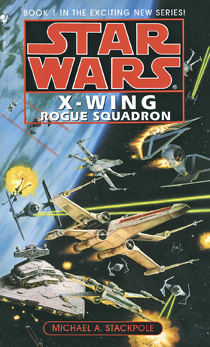Michael A. Stackpole’s “X-Wing: Rogue Squadron” (1996) was the first adult “Star Wars” novel to not feature any of the main characters from the films. Today, with so many novels set well before the film heroes were even born, it is well known that “Star Wars” fans simply like good stories. But at the time, it was probably seen as a risky move by Bantam.
It shouldn’t have been, though: The Fall 1994 issue of Star Wars Insider (No. 23) included an essay called “The Cult of Wedge.” Jon Bradley Snyder wrote:
Wedge deserves the crown as the greatest of all the small characters for making brief appearances in all three films, a feat matched by no other minor character. … Wedge is the only known Rebel pilot to fight and survive both Death Star battles. … For every Luke Skywalker, Princess Leia and Han Solo out there making the big genius moves that save the day, there have to be 100 Wedges backing them up.
Interestingly, in “Rogue Squadron” — which takes place between the Battle of Endor and the “Thrawn Trilogy” and launches a four-book arc of the Rebellion’s taking of Coruscant — Wedge Antilles still isn’t the main character, although he does get a lot of page time as the commander of Rogue Squadron. Rather, up-and-coming pilot Corran Horn — a former Corellian Security officer who maybe, just maybe, has a touch of Force ability — is the main character.
Both Wedge and Corran are the Everyman in ways Luke and Han can’t be due to their widespread hero status, and Stackpole understood readers’ hunger for such characters (He simultaneously wrote “Rogue Squadron” comics that take place before the books, and the “X-Wing” novel series now numbers 10, with Aaron Allston writing half of them). Furthermore, at a time when superweapons and supervillains dominated “Star Wars” fiction, he pared things back with a mix of military strategy, tech savvy and — most importantly — the tight makeshift family that can only come from being in a life-or-death fighter squadron.
Although the other surviving Rogues with movie lines — Janson, Hobbie and Zev — aren’t on hand here (the former two can be found in the comics and Allston’s “X-Wing” work), it doesn’t really matter because Stackpole makes a reader care about all the members of the reformed 12-member squadron. Admiral Ackbar and other Rebellion bigwigs want a group that will not only feature the best pilots, but will also score public-relations victories with each successful mission as the name Rogue Squadron becomes associated with liberty and heroism on all the on-the-fence planets throughout the Empire.
The idea of the Rebellion finally vanquishing the Empire in the military trenches makes perfect sense, because while the Lukes and Leias and Hans briefly team up with the military, they are mostly dealing with family issues that just happen to affect the galactic power structure. In that sense, the Wedges, Tychos and Corrans are the real heroes.
“Rogue Squadron” has a sense of fun: Corran and fellow hotshot Bror Jace keep a running tally of Imp kills. The book has mystery: Why does the Rebel Alliance brass keep such a close eye on Tycho? It has romance: Will Corran choose Erisi or Mirax? It explores the horrors of war: Wedge reflects on the late Biggs Darklighter (of the first Death Star battle) to Biggs’ young cousin Gavin, who is himself dealing with the loss of a friend and squadron-mate. And “Rogue Squadron” has compelling villains driven by brains more so than high emotions: Imperial Intelligence head Ysanne Isard; agent Kirtan Loor, who has a photographic memory; and General Derricote, who looks to secure a little slice of the galactic-power pie on Borleias.

Stackpole respects and enhances other “Star Wars” works. I mean, for crying out loud, he even references the obscure Blackthorne Comics “Star Wars 3-D” No. 1 by mentioning the alien to whom Luke donated his uncle’s moisture farm.
There is one moment when the author misses the mark. It’s always interesting to go back and see how pre-2002 stories got tripped up by “Attack of the Clones.” Although Timothy Zahn barely avoided gaffes in his novels, on page 177 of “Rogue Squadron,” Stackpole makes the mistake of assuming the Clone Wars marked a victory for the Jedi and that the Jedi Purge happened after the wars. Captain Afyon is talking to Wedge about how heroes are defined:
“I guess I just remember the Clone Wars and how the ‘hero’ labels were handed out. You’d think a dozen Jedi and two dozen snubby jocks won the whole thing. Even all the years I spent pulling for peace — same as most of the rest of the folks on Alderaan — never dulled the feeling of injustice I had concerning credit for the war.”
This quote, of course, makes no sense, because we now know that Palpatine managed to vilify, rather than give credit to, the Jedi heroes of the Old Republic. Still, it’s just one quote and it didn’t take me out of the flow of the book for long. And “Rogue Squadron” — with the possible exception of some of the detail-heavy dogfights, and a few more typos that is the norm for a “Star Wars” book (I noticed about a half-dozen) — does flow nicely. It sets up a series that was not merely embraced despite lacking the main characters, it was embraced largely because it lacked the main characters.

